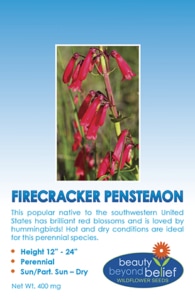Start Your 4th of July Party Now
Celebrate with Firecracker Penstemon
By: Sandy Swegel
Get your Fireworks and start your 4th of July party now. One of my favorite things about perennials is that you plant them once and they bloom year after year. Their appearance every year becomes one of the sweet rituals of the garden. Bright red Firecracker Penstemon is a favorite neighborhood ritual of mine. Some 15 years ago an older lady in the neighborhood planted red firecracker penstemons around her mailbox on the street. She called it the 4th of July flower because the little stand of 3- ft tall red flowers that had grown around her mailbox in the hot beating sun were always in bloom on the 4th of July. Over time, the display got more elaborate as purple salvia were planted at the base of the penstemon. Later white alyssum was growing all around in the rocks. It was a true red white and blue extravaganza.
A few years later I noticed other mailboxes in this suburban neighborhood had firecracker penstemons growing up around them. The whole street was decorated for the 4th of July. I never did find out if everyone liked the idea and planted penstemon too or if some middle of the night guerilla gardener spread penstemon seed everywhere.
Firecracker penstemon is a good choice for mailboxes in the sun next to the street because it tolerates high heat and drought which both plague mailboxes in the sun next to concrete sidewalks. The only caveat is that penstemon is one of those perennials that doesn’t bloom until its second year, so you’ll have to wait a bit for the start of your annual your 4th of July explosion of red.
Photocredits:
https://nargs.org/forum/penstemon-eatoni-eaton-firecracker-or-firecracker-penstemon
http://extension.usu.edu/rangeplants/htm/firecracker-penstemon


 the Midwest, the monarch’s only food. Native habitat in which milkweed thrives has been destroyed as prairie turns to endless mono-crops of Roundup-drenched fields of corn. There are other factors such as massive deforestation in Mexico and the transition of prairie land to suburbia. But no milkweed means the monarch starves.
the Midwest, the monarch’s only food. Native habitat in which milkweed thrives has been destroyed as prairie turns to endless mono-crops of Roundup-drenched fields of corn. There are other factors such as massive deforestation in Mexico and the transition of prairie land to suburbia. But no milkweed means the monarch starves.